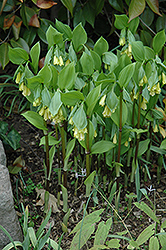Height: 24 inches
Spread: 3 feet
Sunlight:
![]()
![]()
Hardiness Zone: 5a
Other Names: Yellow Fairy Bells, Bellwort
Description:
This plant produces pendulous yellow bells that become more showy as the clump matures; bright green, ovate foliage is attractive; excellent for woodlands or shaded borders
Ornamental Features
Korean Fairy Bells features showy yellow bell-shaped flowers dangling from the stems from early to mid spring. Its oval leaves remain green in colour throughout the season. It produces black berries in late summer.
Landscape Attributes
Korean Fairy Bells is an herbaceous perennial with an upright spreading habit of growth. Its medium texture blends into the garden, but can always be balanced by a couple of finer or coarser plants for an effective composition.
This is a high maintenance plant that will require regular care and upkeep, and is best cleaned up in early spring before it resumes active growth for the season. Gardeners should be aware of the following characteristic(s) that may warrant special consideration;
- Spreading
Korean Fairy Bells is recommended for the following landscape applications;
- Mass Planting
- Border Edging
- General Garden Use
- Naturalizing And Woodland Gardens
Planting & Growing
Korean Fairy Bells will grow to be about 24 inches tall at maturity, with a spread of 3 feet. Its foliage tends to remain dense right to the ground, not requiring facer plants in front. It grows at a fast rate, and under ideal conditions can be expected to live for approximately 10 years. As an herbaceous perennial, this plant will usually die back to the crown each winter, and will regrow from the base each spring. Be careful not to disturb the crown in late winter when it may not be readily seen!
This plant does best in partial shade to shade. It does best in average to evenly moist conditions, but will not tolerate standing water. It is particular about its soil conditions, with a strong preference for rich, acidic soils. It is somewhat tolerant of urban pollution. This species is not originally from North America. It can be propagated by division.
Disclaimer - This resource is provided for informational purposes only and does NOT reflect current availability. Inventory varies seasonally, so we cannot guarantee that every plant will be in stock at all times - please contact your favourite GardenWorks location directly for current availability. It does not include our entire inventory of plants, so be sure to visit GardenWorks to see varieties that may not be represented on this list.

